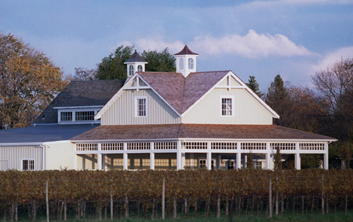Visiting Prague? Get Outta Town — Bohemia and Moravia (Gently) Rock
March 17, 2010 at 10:38 am | Posted in Czech Republic, Europe, wine tourism | Leave a commentTags: beer, Bohemia, Cesky Krumlov, Czech Republic, Jindrichuv Hradec, Karlovy Vary, Karlsbad, Lednice, Mikulov, Moravia, Pilsen, pivo, Plzen, Prague, Telc, Valtice, wine, wine country
by Jacy Meyer
 Sure, the capital of the Czech Republic is a many splendored thing, and 60 percent of visitors venture nowhere else in the country. But what they’re missing is massive, from ancient castles and abbeys to some of the world’s most gorgeous spas and best beer, along with lodging and dining that both of fine quality and highly affordable. You may have even heard of the likes of Karlovy Vary (aka Karlsbad) and UNESCO World Heritage Sites Český Krumlov and Telč. But here are five of my lesser known favorites, all within four hours’ drive of Prague.
Sure, the capital of the Czech Republic is a many splendored thing, and 60 percent of visitors venture nowhere else in the country. But what they’re missing is massive, from ancient castles and abbeys to some of the world’s most gorgeous spas and best beer, along with lodging and dining that both of fine quality and highly affordable. You may have even heard of the likes of Karlovy Vary (aka Karlsbad) and UNESCO World Heritage Sites Český Krumlov and Telč. But here are five of my lesser known favorites, all within four hours’ drive of Prague.
Jindřichův Hradec In south Bohemia, beloved of Czechs but very beneath the tourist radar, JH has small-town charm, a great castle, nature right nearby — and a line proudly marking the 15th longitude meridian. The Renaissance castle complex is the third largest in the country, with some great frescos from the 1300’s; a round garden pavilion; and a Gothic palace. Other highlights include the 14th-century Church of Our Lady with its frescoes, and an unusual eyepopper: in the city history museum, ensconced in a former Jesuit seminary, is the world’s largest mechanical nativity scene, built over six decades in the 19th century and containing nearly 1,400 figures. Just out of town, hitch a ride on the narrow gauge (rails a mere 30 inches/760 mm apart) steam railway, the only one remaining in Bohemia; it rolls you through some lovely valleys, hills, and forests, practically up to the border with Austria.
Mikulov Moravia is known for its wines (which have been becoming ever more respectable by world standards), so a visit to a local vinárna (wine cellar) like Mikulovský Šenk (great outdoor terrace!) to sip the goods is a must. Right on the Austrian border, Mikulov (above right) was also historically famed for its religious tolerance and boasts many pilgrimage sites, including the Svatý Kopeček (“Holy Hill”), a slightly steep climb from the city center, here you’ll find a number of St. Sebastian’s Church, whose belfry offers great views. There are several Jewish sites here, too, such as the Upper Synagogue and a 15th- century cemetery. Off the city’s main square is St. Wenceslas Church with its small ossuary; right across the square in the Dietrichstein tomb you can check out skeletons of aristocrats. Finally, don’t miss the Baroque chateau looming over the city — probably its single most handsome feature.
Plzeň Don’t recognize the name? “Pilsen” ring a bell instead? Bohemia’s famous for its pivo (beer), and anyone who enjoys a nice cold one should appreciate the work of the brewers in the country’s fourth largest city, a couple of hours west of Prague. They came up with bottom-fermented lager in the mid-1800s lager, and now most beer around the world is made this way. The Pilsener Urquell brewery’s interesting tour ends with a tasting of unpasteurized and unfiltered beer straight from the oak barrels. But don’t neglect the rest of Plzeň, starting with the huge main square, dominated by the Cathedral of St. Bartholomew, which boasts the country’s highest tower and terrific countryside views; architecture fans will appreciate the sgraffitto and other Renaissance detail, some by Italians, others by well-known Czechs. The tourist information office on the square offers a map with a do-it-yourself walking tour covering the most historic buildings. Two other must-sees include the Patton Memorial, paying homage to American soldiers who liberated the city in World War II, and the Techmania Science Center, an interactive museum for all ages.
Tábor About 90 minutes’ drive south of Prague, fetchingly perched on a hill over Central Europe’s largest manmade lake, this town’s old quarter is a compact 15th-century charmer, with narrow lanes zigging and zagging all over the place. Named after the biblical Mount Tabor, the town earned notoriety in the 1400s thanks to its Reformation-era religious freedom and experimentation — and the subsequent attempts to extinguish them in the Hussite wars. Its defenders would gather in the large main Žižka Square, and the streets were deliberately made difficult to confuse invaders. But its best-known attraction is under your feet; after exploring “up top” and perusing the Old Town Hall’s Hussite museum, climb down the steep steps to a warren of damp tunnels once used for storing food, making beer , stashing prisoners, and hiding from attacks; a half mile is open to visitors.
Valtice/Lednice These next-door towns are less than an hour’s drive from Mikulov, and what makes them special is the Baroque complex built by the aristocratic Lichtenstein family. It spans 618 acres (250 hectares) between the two towns, including chapels, statuary, ponds, woods, and an easy seven-mile (11-km) path connecting the towns. Each town has a slightly different feel; I think that overall Valtice is more attractive, with better restaurants and hotels, even though the castle is a bit more rundown than Lednice’s (do check out, though, the castle’s new Tiree Chmelar herb garden, opening May 29, 2010). Around here, too, wine is big, and at Valtice’s National Wine Bank you can taste the Czech Republic’s top 100 wines (pace yourself). Lednice is a bit bland but does sport one of the country’s most appealing castles, complete with a minaretlike tower and boat rides on its canals. And for an odd final touch, don’t miss the Agricultural Museum, which for some surely good reason displays a massive mammoth head.
Coming soon: the spectacular spa towns of Bohemia.
New York’s Long Island Wineries An Inebriating Off-Season Getaway
October 5, 2009 at 9:04 am | Posted in off-season travel, wine tourism | Leave a commentTags: Cabernet Franc, Champagne, Chardonnay, East End, Greenport, Hamptons, Jamesport, Long Island, Mattituck, Meritage, Merlot, North Fork, Peconic, Sagoponack, South Fork, wine, wine country, wine tourism
by Jordan Simon

Merlot meets clapboard: Bedell Cellars is a prime example of a swell winery visit on Long Island's North Fork.
Despite its bodacious beaches and historic towns, New York State’s Long Island still cruises medium to low on the travel radar. Most Americans — even many New Yorkers — who know anything about the largest island in the U.S., flaring out from the Big Apple like an enormous forked tongue, think: NYC bedroom communities, then beaches (Fire Island, the tony Hamptons).
But how many appreciate that not only does New York State harbor the country’s oldest continuously operated winery, but that the Hamptons teemed with vineyards 150 years ago and today’s East End offers some of America’s most engaging, even eminent wine country?
Indeed, the region bears an uncanny geographic resemblance to Bordeaux, whose top varietals thrive in similar conditions: a temperate maritime climate warm enough to ripen the fruit, cool enough to produce brisk acidity, while the breezes extend the frost-free growing season, reduce temperature extremes, and concentrate precipitation in the desired winter months. I consider the Island’s red Bordeaux varietals — especially the earlier-ripening Merlot and Cabernet Franc — its top products; its Meritage blends are also excellent. The Cab Francs are the New World’s most promising and complex, exhibiting the grape’s tannic masculinity yet elegance, with textbook aromas and flavors but distinctive terroir-driven notes. Along with some notable whites, sparklers, and rosés, these wines are produced to pair with the region’s rich bounty, from oysters to duck. Vintners experiment and marry newfangled equipment with Old World knowledge, including globally “imported” winemakers and consultants.
Forty-one wineries (most along a 22-mile North Fork stretch) welcome visitors for tours and tastings; you can decide which Long Island wines strike your fancy at LIWines.com. Though tendrils of trendiness creep across the Long Island Sound, the increasingly Napa-fied North Fork remains down-home compared to the South Fork’s upscale Hamptons, with rates surprisingly low now during fall harvest time, when leaves turn pyrotechnically. After beach season, activities still abound: wildlife reserves, historic villages and lighthouses, art galleries, even some outlet shopping.
There’s also a nice selection of family-run motels, inns, B&Bs, even farmhouses — many historic — which often reflect innkeepers’ charming idiosyncrasies (Red Barn B&B has its own astronomical observatory, Freddy’s House B&B a working hydrangea farm), offering warmth over whimsy. In Greenport, I particularly like the Norman-Rockwellian Harborfront Inn (from $199, including dinner credit and bottle of wine), contrasting traditional architecture with contemporary style and amenities, and Bartlett House (from $150), whose rooms (some Asian- and African-themed) exhibit fabulous flair. Meanwhile, in Mattituck, Shinn Family Vineyards Estate Farmhouse is the Island’s only working winery where you can stumble into bed after a vino-soaked evening (from $149). The Country Inn at Jamesport (from $100) and Greenport’s beachfront Silver Sands Motel (from $125) should satisfy savings seekers.
Eats-wise, among the better restaurants, most emphasize a warm, family-run welcome and fresh, seasonal, local “slow” food. My picks: Greenport’s Bay & Main, Soundview, or Scrimshaw; Mattituck’s Touch of Venice; Jamesport Manor Inn, and Jamesport Country Kitchen; Shelter Island’s Vine Street Café and Pridwin Beach Hotel; and Southold’s North Fork Table & Inn.
As for the wineries themselves, many respect traditional “shack chic” architecture, renovating weatherbeaten potato barns, while a few reflect their powerhouse owners’ less grapey passions. Many offer regular events and entertainment such as live music spring through fall. Here’s a quick tasting, all with daily tastings year round (other top options include Macari, Martha Clara, Palmer, Paumanok, Roanoke); swirl and spit, please.
Bedell Cellars In Cutchogue, on the North Fork, Kip Bedell earned the moniker “Mr. Merlot” pioneering the prevailing style: Upon release, they’re “young, virile, and awkward,” Bedell laughs, yet upon maturing purr with Porsche power and polish. The tasting room, a soaring expansion of the original 1919 barn, holds owner Michael Lynne’s world-class art collection. Tastings from $8 per person.
Lenz Winery One of the North Fork’s oldest, occupies an original Peconic barn sporting timber beams and thatching; photos of the vineyards and workers adorn rough-hewn walls. Far from being rustic, Eric Fry’s wines display exceptional finesse; in blind tastings his Chardonnays and Merlots have tied with French bottlings, including the fabled Pétrus (8x the price), and his bubblies compare favorably with artisan Champagnes. Tastings from $5.
Raphael Winery Also in Peconic, the architectural style’s Italianate, including a bell tower, thick wood beams, stone columns, hand-carved zigzagging staircases, marble accents, vaulted ceilings, and medieval tapestries. The vinous style’s more French (Bordeaux biggie Paul Pontallier of Château Margaux was originally a consultant), starring mesmerizing Merlots and sassy Sauvignon Blanc. Tastings from $8.
Wölffer Estate Near the Hamptons town of Sagoponack, German-born mega-developer Christian Wölffer’s 55-acre Tuscan-style spread is all beam-crossed cathedral ceilings, terracotta floors, massive French doors, spidery wrought-iron chandeliers, and stained glass, showcasing Wölffer’s centuries-old pewter and faïence mug collection, botanical gardens, and equestrian center (hey, it’s polo/Ralph Lauren country, too). Chardonnay, Merlot, and rosé are the name of winemaker Roman Roth’s game. Tastings from $12.
More info: Tripatini.com’s Wine Tourism and New York State groups.
Blog at WordPress.com.
Entries and comments feeds.
